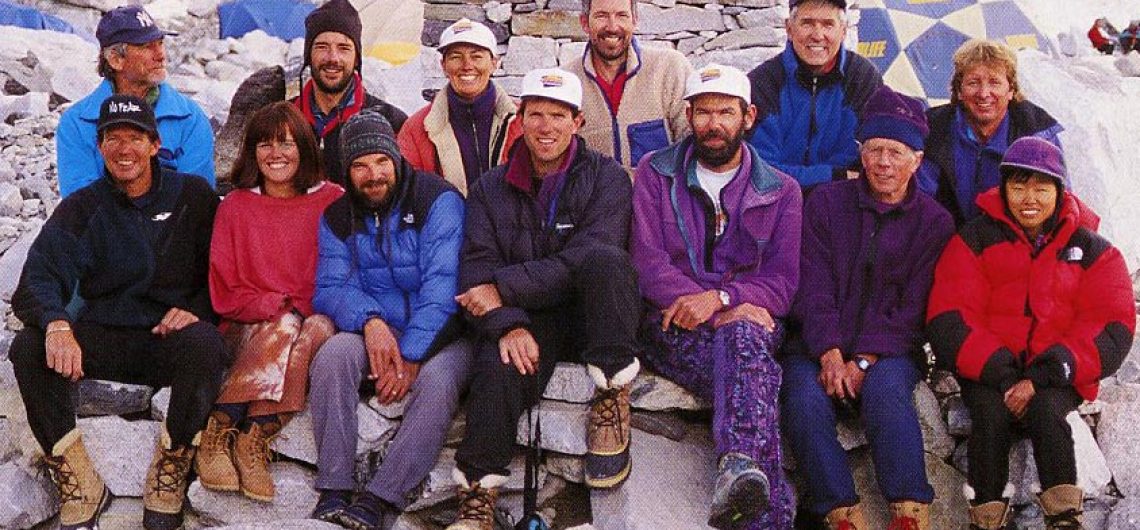Doug Hansen was an American mountaineer and postal worker who perished in the Mount Everest catastrophe in 1996. Hansen, nicknamed the “mailman” because of his occupation, was a member of Rob Hall’s Adventure Consultants team, which attempted to summit Everest during the 1996 climbing season. Unfortunately, due to a combination of factors such as poor decision-making, a fierce blizzard, and unexpected delays, the expedition turned disastrous.
Universal Studios released the financially successful film ‘Everest’ in 2015, starring Jason Clarke, John Hawkes, Keira Knightley, Jake Gyllenhaal, Michael Kelly, and others.
It eventually made $203 million globally. The film was inspired by true occurrences. Doug Hansen, the mailman who conquered Everest, was played by John Hawkes in the film.
About Doug Hansen, “The Mailman”
Doug Hansen, born in 1949 in Seattle, Washington, grew up in poverty. Hansen worked two jobs to make ends meet. He was a mail worker as well as a driver. Growing up in poverty did not deter him from aspiring to climb Mount Everest, the highest mountain on the planet.
Mount Rainier, which is 59 miles southwest of Seattle, may have influenced Hansen. He was resolved to climb Everest as he grew older. Doug Hansen, the ‘mailman’ who climbed Mount Everest, is an average man who accomplished an exceptional achievement.
Hansen’s tale is one of tenacity, dedication, and the triumph of the human spirit. Hansen tried to climb Mount Everest in 1995 as part of an Adventure Consultants trip headed by Rob Hall, an established New Zealand climber. Due to severe weather, he had to turn back barely 300 meters from the peak.
Hansen was unable to consider a second try since the charge to climb Everest under Rob’s guidance was $65,000 per person. However, because Hall liked Doug, he offered a significant discount in fees to climb again in 1996. Doug was also motivated by Kent kids who gave him a little flag to place at the summit of Everest. He had taken out a mortgage on his house to fund the climb.
Expedition of Adventure Consultants in 1996
The Adventure Consultants’ trip to Mount Everest in 1996 was a commercial climbing expedition headed by Rob Hall. The expedition crew included the postmaster, Doug Hansen, as well as many clients and expert Sherpa climbers.
The rescue became considerably more difficult due to the tough alpine conditions. During the storm, eight climbers died on the mountain, including Hall and Hansen.
Rob Hall’s Adventure Consultants and Scott Fischer’s Mountain Madness competed in the 1996 trip. Scott Fischer, an experienced American guide, teamed up with Hall to accompany their respective customers to the peak of Everest. During this ascent, Fischer and his clients successfully reached the summit.
In order to escape the terrible weather conditions and low sights that are frequent on Everest, Rob Hall set a 2 p.m. deadline for his customers to reach the summit. However, delays were caused by congestion at the base of the Hillary Step and the expedition Sherpas’ inability to fix ropes in a timely manner. Only a few climbers had made it to the summit by 2 p.m. Hall decided to extend the deadline after learning that his opponent, Scott Fischer, had successfully climbed with his clientele. Around 4 p.m., Hall and his clients reached the summit of Mount Everest.
The trip has received much examination and research, raising concerns about the commercialization of Everest climbing and the hazards that come with it.
The book ‘Into Thin Air’ by Jon Krakauer chronicles the tragic occurrence, which is recognized as one of the worst climbing catastrophes in Mount Everest history.
At high elevations, oxygen levels drop as one ascends, resulting in persistent weariness and frequent hyperventilation. When compared to sea level, Mount Everest has one-third less oxygen. Acclimatization is required even for lesser, trekkable mountains in Nepal. Continuing to reach higher elevations without sufficient acclimatization is dangerous. A month of acclimatization is necessary to conquer Mount Everest.
Doug had breathing problems during acclimation. Jon Krakauer, a fellow climber on the expedition, had to rouse Doug from his sleeping bag two weeks before the final ascent on April 26th, after Doug voiced worries about his throat and reservations about his ability to climb owing to his age.
Doug noticed frostbite sprouting on the toes he had previously lost on his 1995 ascent the same day. Doug advised Hall before the last ascent that he might not be able to ascend Everest because he was uncomfortable and hard to communicate. Hall urged Doug to keep going. Despite his reservations, Doug was hesitant to abandon the climb because he had put significant effort, money, and time into it and had ultimately decided to continue.
Doug Hansen was not feeling well on the last day. He told his teammates that he hadn’t eaten or slept well in several days and that he wanted to drop. Doug, though, chose to continue the ascent after a quick talk with Hall.
Doug Hansen and his buddy spent many weeks before the expedition acclimatizing and erecting camps at various spots on the mountain. On May 10, 1996, Hansen and other members of Rob’s crew reached the top of Mount Everest. However, during their descent, the team was caught in a severe storm with high winds and sub-zero temperatures.
What actually happened to Doug Hansen?
Hansen and Rob returned to base camp after a brief stay at the summit of Everest. They had depleted their supply of supplementary oxygen. Doug quickly got physically and psychologically exhausted. Doug had also had a small throat surgery before departing for Nepal, and the aftereffects were terrible. Hall had then recommended him to postpone the meeting for a few of days.
Rob tried to persuade Doug to keep crawling, but Doug was already exhausted and hypothermic. Rob was unable to leave his client alone or assist him in descending the treacherous Hillary Step. By 6 p.m., Hall had descended alone to the South Summit.
Andy Harris, a member of Hall’s crew, discovered Hansen and attempted to give him oxygen, but he was too weak to continue. Harris eventually had to leave Hansen in order to preserve his own life. Doug Hansen and Andy Harris had lost communication with Rob by this stage. When stranded, Hall radioed for assistance but died along with the other climbers.
Was Doug Hansen’s body ever found on Everest?
Hansen’s remains stayed on the mountain for several years before being found by another expedition in 2005.
Andy Harris, a member of Hall’s crew, discovered Hansen and attempted to give him oxygen, but he was too weak to continue. Harris eventually had to leave Hansen in order to preserve his own life. Doug Hansen and Andy Harris had lost communication with Rob by this stage. When stranded, Hall radioed for assistance but died along with the other climbers. Hansen’s remains stayed on the mountain for several years before being found by another expedition in 2005.
What killed Doug Hansen on Everest??
The specifics of Doug’s demise that evening remains unknown. He may have lost his balance and fallen 7,000 feet to his death. Later, his ice axe was discovered lodged in the ridge. Having difficulty moving as a result of
![]()


Comments